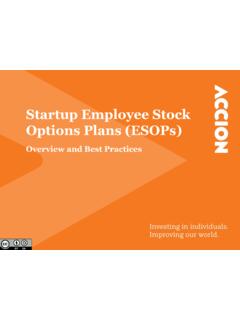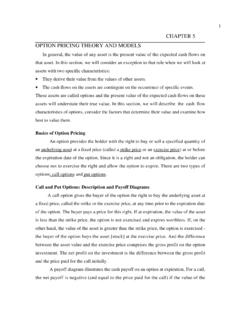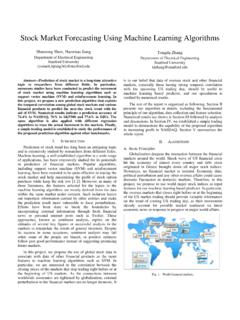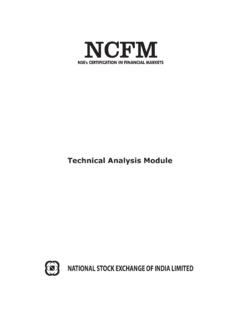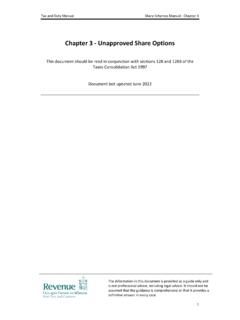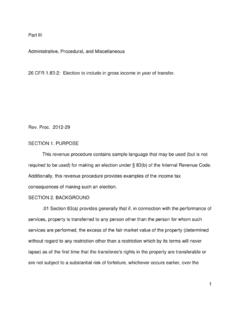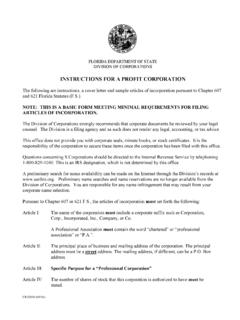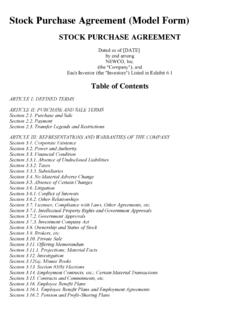Transcription of Problem 9 - California State University, Northridge
1 Problem Suppose that a European call option to buy a share for $ costs $ and is held until maturity. Under what circumstances will the holder of the option make a profit? Under what circumstances will the option be exercised? Draw a diagram illustrating how the profit from a long position in the option depends on the stock price at maturity of the option. Ignoring the time value of money, the holder of the option will make a profit if the stock price at maturity of the option is greater than $105. This is because the payoff to the holder of the option is, in these circumstances, greater than the $5 paid for the option. The option will be exercised if the stock price at maturity is greater than $100.
2 Note that if the stock price is between $100 and $105 the option is exercised, but the holder of the option takes a loss overall. The profit from a long position is as shown in Figure Figure Profit from long position in Problem Problem Suppose that a European put option to sell a share for $60 costs $8 and is held until maturity. Under what circumstances will the seller of the option (the party with the short position) make a profit? Under what circumstances will the option be exercised? Draw a diagram illustrating how the profit from a short position in the option depends on the stock price at maturity of the option. Ignoring the time value of money, the seller of the option will make a profit if the stock price at maturity is greater than $ This is because the cost to the seller of the option is in these circumstances less than the price received for the option.
3 The option will be exercised if the stock price at maturity is less than $ Note that if the stock price is between $ and $ the seller of the option makes a profit even though the option is exercised. The profit from the short position is as shown in Figure Figure Profit from short position in Problem Problem A trader buys a call option with a strike price of $45 and a put option with a strike price of $40. Both options have the same maturity. The call costs $3 and the put costs $4. Draw a diagram showing the variation of the trader's profit with the asset price. Figure shows the variation of the trader's position with the asset price.
4 We can divide the alternative asset prices into three ranges: a) When the asset price less than $40, the put option provides a payoff of 40 ST and the call option provides no payoff. The options cost $7 and so the total profit is 33 ST . b) When the asset price is between $40 and $45, neither option provides a payoff. There is a net loss of $7. c) When the asset price greater than $45, the call option provides a payoff of ST 45 and the put option provides no payoff. Taking into account the $7 cost of the options , the total profit is ST 52 . The trader makes a profit (ignoring the time value of money) if the stock price is less than $33 or greater than $52.
5 This type of trading strategy is known as a strangle and is discussed in Chapter 11. Figure Profit from trading strategy in Problem Problem What is a lower bound for the price of a two-month European put option on a non-dividend- paying stock when the stock price is $58, the strike price is $65, and the risk-free interest rate is 5% per annum? The lower bound is 65e 2 /12 58 = $ Problem A four-month European call option on a dividend-paying stock is currently selling for $5. The stock price is $64, the strike price is $60, and a dividend of $ is expected in one month. The risk-free interest rate is 12% per annum for all maturities. What opportunities are there for an arbitrageur?
6 The present value of the strike price is 60e 4=. /12. $ . The present value of the dividend is 1/12. =.. Because 5 < 64 the condition in equation ( ) is violated. An arbitrageur should buy the option and short the stock. This generates 64 5 = $59 . The arbitrageur invests $ of this at 12% for one month to pay the dividend of $ in one month. The remaining $ is invested for four months at 12%. Regardless of what happens a profit will materialize. If the stock price declines below $60 in four months, the arbitrageur loses the $5 spent on the option but gains on the short position. The arbitrageur shorts when the stock price is $64, has to pay dividends with a present value of $ , and closes out the short position when the stock price is $60 or less.
7 Because $ is the present value of $60, the short position generates at least 64 = $ in present value terms. The present value of the arbitrageur's gain is therefore at least = $ . If the stock price is above $60 at the expiration of the option, the option is exercised. The arbitrageur buys the stock for $60 in four months and closes out the short position. The present value of the $60 paid for the stock is $ and as before the dividend has a present value of $ The gain from the short position and the exercise of the option is therefore exactly equal to 64 = $ . The arbitrageur's gain in present value terms is exactly equal to = $ . Problem A one-month European put option on a non-dividend-paying stock is currently selling for $.
8 The stock price is $47, the strike price is $50, and the risk-free interest rate is 6% per annum. What opportunities are there for an arbitrageur? In this case the present value of the strike price is 50e 1/12= . Because < the condition in equation ( ) is violated. An arbitrageur should borrow $ at 6% for one month, buy the stock, and buy the put option. This generates a profit in all circumstances. If the stock price is above $50 in one month, the option expires worthless, but the stock can be sold for at least $50. A sum of $50 received in one month has a present value of $ today. The strategy therefore generates profit with a present value of at least $ If the stock price is below $50 in one month the put option is exercised and the stock owned is sold for exactly $50 (or $ in present value terms).
9 The trading strategy therefore generates a profit of exactly $ in present value terms. Problem Suppose that put options on a stock with strike prices $30 and $35 cost $4 and $7, respectively. How can the options be used to create (a) a bull spread and (b) a bear spread? Construct a table that shows the profit and payoff for both spreads. A bull spread is created by buying the $30 put and selling the $35 put. This strategy gives rise to an initial cash inflow of $3. The outcome is as follows: Stock Price Payoff Profit ST 35 0 3. 30 ST < 35 ST 35 ST 32. ST < 30 5 2. A bear spread is created by selling the $30 put and buying the $35 put.
10 This strategy costs $3. initially. The outcome is as follows: Stock Price Payoff Profit ST 35 0 3. 30 ST < 35 35 ST 32 ST. ST < 30 5 2. Problem A call with a strike price of $60 costs $6. A put with the same strike price and expiration date costs $4. Construct a table that shows the profit from a straddle. For what range of stock prices would the straddle lead to a loss? A straddle is created by buying both the call and the put. This strategy costs $10. The profit/loss is shown in the following table: Stock Price Payoff Profit ST > 60 ST 60 ST 70. ST 60 60 ST 50 ST. This shows that the straddle will lead to a loss if the final stock price is between $50 and $70.










